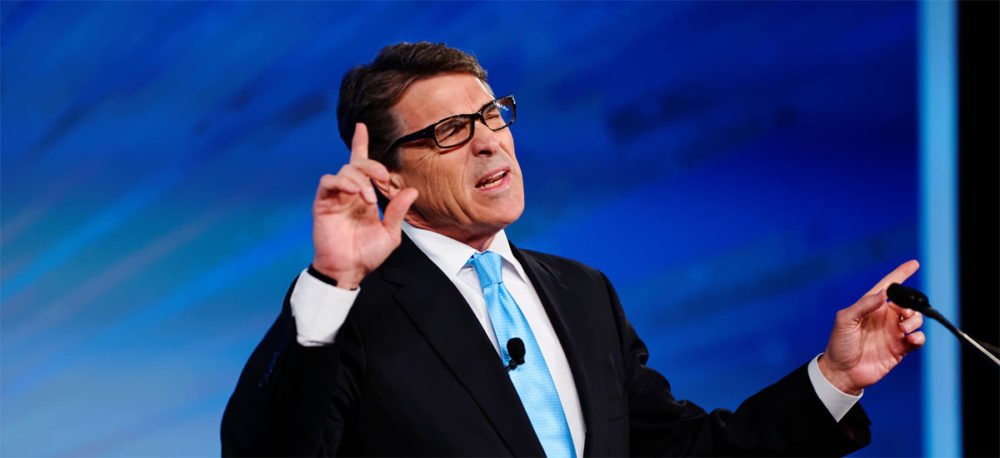On April 14, Energy Secretary Rick Perry requested a 60-day “Study examining electricity markets and reliability.” The study was scheduled to be released on June 26, but it now appears it will be delayed until July. Perry’s letter calling for the study is riddled with flawed assumptions and predetermined conclusions about the value so-called “baseload” coal and nuclear power plants provide to the grid and the impacts renewable energy have on reliability that contradicts overwhelming evidence from dozens of studies by DOE’s own national labs, regional grid operators, and even Perry’s home state of Texas.
Do you think we’re going to learn anything new in 60 days that these experts and real-world experience haven’t already answered over the past decade?
Secretary Perry’s biased and unnecessary study is just yet another blatant attempt by the Trump Administration to prop up the ailing coal industry and undermine important renewable energy policies that are providing clean, reliable, and affordable power to consumers. Renewable energy business associations, Senate Democrats, and even prominent Senate Republican Chuck Grassley from Iowa have raised similar concerns about the study’s motivation and credibility.
What does a credible study look like?
Typically, important tax-payer funded government studies are done in an open and transparent manner over a period of several months or years, with input and review from outside experts, key stakeholders, and the public. This approach helps balance varying viewpoints, avoid political interference, and ensure objectivity.
Here are two examples of DOE studies on renewable energy and reliability that were done the right way:
- NREL’s 2012 Renewable Electricity Futures Study, a massive 850-page study developed by more than 100 experts from 35 diverse organizations and peer-reviewed by more than 140 experts. The study found that with a more flexible electricity system, grid operators would be able to balance electricity supply and demand and maintain reliability in every hour of the year with renewable energy providing 80 percent of US electricity by 2050.
- DOE’s 2015 Wind Vision Study, a comprehensive analysis of the costs and benefits of producing 20 percent of US electricity from wind power by 2030 and 35 percent by 2050. More than 250 experts and 50 organizations—representing the wind industry, utilities, grid operators, non-governmental organizations, and four DOE national labs—contributed to the report.
Perry’s study doesn’t meet these standards
In addition to the absurd 60-day deadline, the study is being conducted behind closed doors with no input or review from outside experts or the public. And the research questions (if you want to call them that) have either been answered already or are clearly biased against renewable energy.
To make matters worse, the study is being directed by individuals who have been openly hostile to renewable energy and supported by the fossil fuel industry. Travis Fisher and his boss Daniel Simmons, appointed by President Trump to oversee DOE’s Office of Energy Efficiency and Renewable Energy (which they once recommended eliminating), are former employees of the Institute for Energy Research (IER), and its advocacy arm, the American Energy Alliance (AEA), which actively supports rolling back state and federal climate and clean energy policies. (For more details, see these blogs by Elliott Negin and Dave Anderson.)
In 2015, Fisher wrote a report for IER calling clean energy policies a greater threat to reliability than extreme weather, cyber attacks, or terrorism. To address this so-called threat, Fisher recommended repealing federal renewable energy tax credits, state renewable energy standards, state net metering policies, and the EPA’s Clean Power Plan and Mercury and Air Toxics Standards.
It’s no secret that the Trump Administration is targeting many of these policies. Perry also made a highly controversial comment at a Bloomberg New Energy Finance Conference in late April saying they were having “very classified” conversations about DOE potentially overturning state and local renewable policies in the name of national security.
What we would expect to see in a rigorous study
If Perry’s grid study is done right, here are 7 important things we would expect it to show based on current trends and recent credible studies:
- Renewables are diversifying the electricity mix (see pie charts), making the grid more reliable and resilient. Regional grid operators and utilities are already integrating high levels of wind and solar of 50 to 60 percent or more of total electricity demand in some parts of the country, including Texas, while maintaining and even improving reliability.
- The national labs, regional grid operators, utilities and others have completed dozens of studies showing that the US can achieve even higher levels of renewable energy in the future, while producing reliable, affordable, and cleaner electricity, as explained in this letter signed by UCS.
- Baseload power plants pose their own reliability challenges because of their large size, limited flexibility, and vulnerability to extreme weather events such as the Polar Vortex, extreme heat and drought impacts on cooling water, and storm surge from Hurricanes. This 2013 DOE report highlights numerous climate and extreme weather-related risks to our energy infrastructure.
- There is widespread agreement from energy experts that low natural gas prices and flat electricity demand are the main causes of recent coal and nuclear retirements, not renewable energy, as highlighted in new report by the Analysis Group.
- Fossil fuels and nuclear power have received far more subsidies than renewable energy historically, and are part of the permanent tax code while tax credits for renewables are set to phase out in a few years.
- The costs of utility scale wind and solar have fallen by more than two-thirds since 2009, which has made renewable energy more affordable to consumers.
- Federal tax credits and state renewable standards have been key drivers for the cost reductions and recent deployment of wind and solar that are creating new jobs and other economic benefits across America, particularly in states and rural areas that voted for President Trump.
Renewable energy and natural gas are diversifying the US electricity mix
The study, not renewables, is a waste of taxpayer money
If Perry’s study reaches different conclusions, or cherry picks information that supports the Trump Administration’s predetermined conclusions, it should raise a major red flag. Perhaps Republican Senator Chuck Grassley from Iowa (which gets 36 percent of its electricity from wind) said it best in his letter to Perry: “I’m concerned that a hastily developed study, which appears to pre-determine that variable, renewable resources such as wind have undermined grid reliability, will not be viewed as credible, relevant or worthy of valuable taxpayer resources.”


